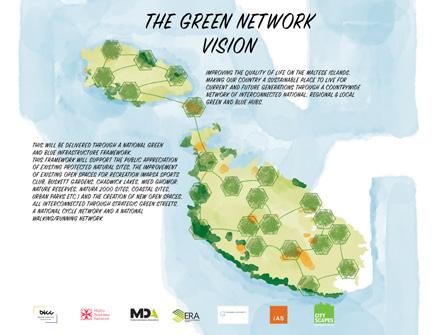
3 minute read
URBAN GREENING
from MONEY ISSUE 61
IN AGREE(N)MENT
Dayna is a senior speech therapist by day and feature writer by night. When she’s not busy fixing words, she is travelling the world to add to her fridge magnet collection.
Advertisement
Imagine a greener Malta, one with functional green spaces serving as the lungs of the island that interconnect, clean, vibrant places you want to spend time with your family and friends. This is still a dream for many, although architect and project manager Charles Saliba hopes to one day make this dream a reality through his Green network vision. Dayna Camilleri Clarke explores.
They say “travel broadens the horizons”. It’s often when we are abroad a great idea can be presented, and you wish it were readily available in your country of origin. It’s precisely this sentiment that occurred to architect and project manager, Charles Saliba. Through working internationally, and now UK based, Saliba felt a fire burning within when it came to Malta’s green spaces. He couldn’t sit back and watch nothing happens, and set about creating a working group to explore initial ideas on how to improve the green spaces of Malta—this led to the creation of the “Green Network” vision.

Saliba’s proposed 10-15 year vision sees the regeneration of Malta’s existing green spaces into more widely used and functional areas, including renovating areas such as Ta’ Qali, Chadwick Lakes and Buskett woodlands. “Improving our green spaces has multiple benefits on our well-being, health, pollution levels and the economy. Creating Malta’s lungs has never been more important, and an accountable body needs to be formed to start auctioning it”, states Charles. “There are countless individuals across the islands doing some incredible work possibly in isolation. These individuals need to be brought together to bring about change”. His vision has already had its seeds planted, having presented the notion to the transport and environment ministers back in January 2019, through the support of the Building Industry Consultative Council.
Saliba states that his vision would also need to involve town planning which ensures the integration of green infrastructure in the planning process. “Each planning approval could have an element of green infrastructure bolted on that contributes to the creation of the overall Green Network vision”.
He strongly believes the answers are already underneath our noses and must start with awareness for the need for such fruitful green spaces. “Here in Malta, we have challenges around a lack of open spaces, obesity, flooding, air pollution and traffic.
We need to change the way people think about being green and the environment.”
Increasing public awareness for the need for change and setting up an accountable body, Saliba believes the third step would be accomplishing a masterplan. A solid nationwide masterplan in which existing open spaces can be identified, together with the creation of new areas supported by the planning process and how they can all be interlinked. “This masterplan would need to be fully incorporated into our town planning policies, through which permitted developments can make their proportionate contribution to making this masterplan come to life. New developments can repay to the community by adding to green areas,” Saliba said.
Saliba believes that after explaining the Green Network in meetings with the BICC and the Maltese government, his proposal can lead to better and greener connections between Malta’s open spaces—allowing a seamless cross over from one local area to the other within regional clusters of green and open spaces.










